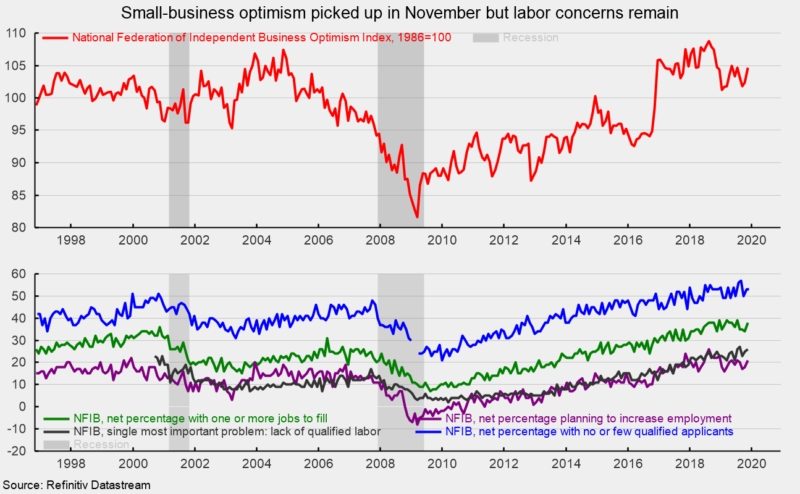Small-Business Optimism Rose in November

The small-business-optimism index from the National Federation of Independent Business rose to 104.7 in November, up 2.3 points from 102.4 in October and it is now 4.1 points below the all-time high of 108.8 in August 2018. The latest result extends a run of 36 consecutive months above 100, averaging 104.9 over the period, a very high figure by historical comparison (see top chart). The strong result was buoyed by positive results for profit trends, plans for expansion, inventory conditions, and job openings. The single most important problem among small businesses remains the declining quality of the available labor force, particularly in the context of an already-tight labor market and a very high percentage of firms with open jobs.
The general outlook remained positive as the percentage of respondents believing now is a good time to expand came in at 29, up from 23 in October. The net percentage of respondents expecting better economic conditions (“better” minus “worse”) came in at 13, up from 10 in October. The net percentage had been in the 40s in 2017 but is still high compared to negative numbers from 2016. A net 13 percent expect higher sales over the coming months while a net 12 percent report higher sales for the most recent three months versus the prior three months.
The percentage of firms planning to increase employment rose to 21 percent from 18 percent in October. A near-record 38 percent (versus a record 39 percent) of firms report having openings they are not able to fill at the moment (see bottom chart). At the same time, the percentage of firms reporting few or no qualified applicants for job openings was 53 percent, unchanged from October and just 4 points below the record 57 percent from August. That combination in the labor market of healthy demand and weak supply has a net 30 percent of firms saying they have already increased compensation over the past three months while 26 percent intend to increase worker pay over the coming months.
The labor-market dynamics have made quality of labor the most important issue for small businesses. Among the 10 issues listed in the survey, quality of labor ranks first at 26 percent, one point below the survey high of 27 percent. Taxes were tied with “other” for second at 14 percent while government regulation and red tape was fourth on the list at 13 percent. Inflation was at the bottom of the list with just 1 percent of respondents identifying it as the single most important problem. Inflation has been at the bottom of the list for several years, reflecting the slow pace of price increases over the current economic cycle.
Capital expenditures by small businesses also remain solid, with 60 percent of such businesses having made capital expenditures during the past six months. That is slightly below the typical percentage in the upper 60s during the late 1990s but well above the mid-40s percentages during the last recession. Thirty percent of firms have plans for capital expenditures over the next three to six months, up from 29 percent in the prior month.
Overall, the survey suggests the small-business sector of the economy remains strong and views of the future remain upbeat.





